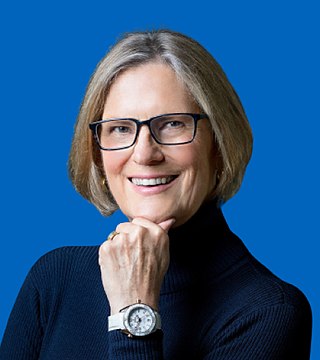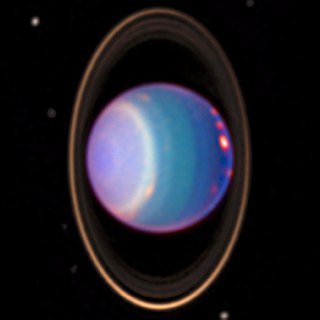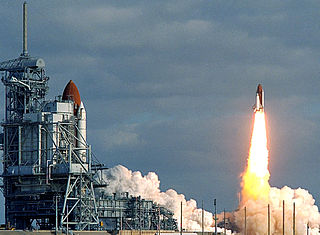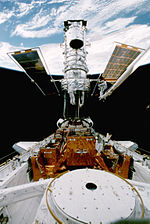
The Hubble Space Telescope is a space telescope that was launched into low Earth orbit in 1990 and remains in operation. It was not the first space telescope, but it is one of the largest and most versatile, renowned as a vital research tool and as a public relations boon for astronomy. The Hubble telescope is named after astronomer Edwin Hubble and is one of NASA's Great Observatories. The Space Telescope Science Institute (STScI) selects Hubble's targets and processes the resulting data, while the Goddard Space Flight Center (GSFC) controls the spacecraft.

STS-31 was the 35th mission of NASA's Space Shuttle program. The primary purpose of this mission was the deployment of the Hubble Space Telescope (HST) into low Earth orbit. The mission used the Space Shuttle Discovery, which lifted off from Launch Complex 39B on April 24, 1990, from Kennedy Space Center, Florida.

Kathryn Dwyer Sullivan is an American geologist, oceanographer, and former NASA astronaut and US Navy officer. She was a crew member on three Space Shuttle missions.

Steven Alan Hawley is a former NASA astronaut who flew on five U.S. Space Shuttle flights. He is professor of physics and astronomy and director of engineering physics at the University of Kansas.

STS-51 was a NASA Space Shuttle Discovery mission that launched the Advanced Communications Technology Satellite (ACTS) in September 1993. The flight also featured the deployment and retrieval of the SPAS-ORFEUS satellite and its IMAX camera, which captured spectacular footage of Discovery in space. A spacewalk was also performed during the mission to evaluate tools and techniques for the STS-61 Hubble Space Telescope (HST) servicing mission later that year. STS-51 was the first shuttle mission to fly a Global Positioning System (GPS) receiver, a Trimble TANS Quadrex. It was mounted in an overhead window where limited field of view (FoV) and signal attenuation from the glass severely impacted receiver performance. Full triple-redundant 3-string GPS would not happen until 14 years later with STS-118 in 2007.

STS-61 was NASA's first Hubble Space Telescope servicing mission, and the fifth flight of the Space Shuttle Endeavour. The mission launched on December 2, 1993, from Kennedy Space Center (KSC) in Florida. The mission restored the spaceborne observatory's vision with the installation of a new main camera and a corrective optics package (COSTAR). This correction occurred more than three and a half years after the Hubble was launched aboard STS-31 in April 1990. The flight also brought instrument upgrades and new solar arrays to the telescope. With its very heavy workload, the STS-61 mission was one of the most complex in the Shuttle's history.

Curtis Lee "Curt" Brown Jr. is a former NASA astronaut and retired United States Air Force colonel.

STS-95 was a Space Shuttle mission launched from Kennedy Space Center, Florida on 29 October 1998, using the orbiter Discovery. It was the 25th flight of Discovery and the 92nd mission flown since the start of the Space Shuttle program in April 1981. It was a highly publicized mission due to former Project Mercury astronaut and United States Senator John H. Glenn Jr.'s return to space for his second space flight. At age 77, Glenn became the oldest person to go into space, a record that remained unbroken for 23 years until 82-year-old Wally Funk flew on a suborbital flight on Blue Origin NS-16, launching on 20 July 2021, which in turn was broken by William Shatner at age 90 on 13 October 2021. Glenn, however, remains the oldest person to reach Earth orbit. This mission is also noted for inaugurating ATSC HDTV broadcasting in the U.S., with live coast-to-coast coverage of the launch. In another first, Pedro Duque became the first Spaniard in space.

STS-103, the 96th launch of the Space Shuttle and the 27th launch of Space Shuttle Discovery, was a Hubble Space Telescope servicing mission. It launched from Kennedy Space Center, Florida, on 19 December 1999 and returned on 27 December 1999 and was the last Shuttle mission of the 1990s. It was the only mission to span through Christmas after being delayed by 13 days for technical and weather reasons.

STS-109 (SM3B) was a Space Shuttle mission that launched from the Kennedy Space Center on 1 March 2002. It was the 108th mission of the Space Shuttle program, the 27th flight of the orbiter Columbia and the fourth servicing of the Hubble Space Telescope. It was also the last successful mission of the orbiter Columbia before the ill-fated STS-107 mission, which culminated in the Columbia disaster.

John Mace Grunsfeld is an American physicist and a former NASA astronaut. He is a veteran of five Space Shuttle flights and has served as NASA Chief Scientist. His academic background includes research in high energy astrophysics, cosmic ray physics and the emerging field of exoplanet studies with specific interest in future astronomical instrumentation. After retiring from NASA in 2009, he served as the deputy director of the Space Telescope Science Institute in Baltimore, Maryland. In January 2012, he returned to NASA and served as associate administrator of NASA's Science Mission Directorate (SMD). Grunsfeld announced his retirement from NASA in April 2016.

Gregory Jordan "Greg" Harbaugh is an aeronautical/astronautical engineer and former NASA astronaut. He flew on four space shuttle missions as a mission specialist with responsibilities that included Remote Manipulator System (RMS) operation and Extravehicular Activity (EVAs). He performed three spacewalks during the shuttle missions including in support of repair/refurbishment of the Hubble Space Telescope.

Richard Michael Linnehan is a United States Army veterinarian and a NASA astronaut.

NASA's series of Great Observatories satellites are four large, powerful space-based astronomical telescopes launched between 1990 and 2003. They were built with different technology to examine specific wavelength/energy regions of the electromagnetic spectrum: gamma rays, X-rays, visible and ultraviolet light, and infrared light.

The Space Telescope Imaging Spectrograph (STIS) is a spectrograph, also with a camera mode, installed on the Hubble Space Telescope. Aerospace engineer Bruce Woodgate of the Goddard Space Flight Center was the principal investigator and creator of the STIS. It operated continuously from 1997 until a power supply failure in August 2004. After repairs, it began operating again in 2009. The spectrograph has made many important observations, including the first spectrum of the atmosphere of an extrasolar planet, HD 209458b.

The Near Infrared Camera and Multi-Object Spectrometer (NICMOS) is a scientific instrument for infrared astronomy, installed on the Hubble Space Telescope (HST), operating from 1997 to 1999, and from 2002 to 2008. Images produced by NICMOS contain data from the near-infrared part of the light spectrum.

The Goddard High Resolution Spectrograph was an ultraviolet spectrograph installed on the Hubble Space Telescope during its original construction, and it was launched into space as part of that space telescope aboard the Space Shuttle Discovery on April 24, 1990 (STS-31). The instrument is named after 20th century rocket pioneer Robert H. Goddard.

The Hubble Deep Field South is a composite of several hundred individual images taken using the Hubble Space Telescope's Wide Field and Planetary Camera 2 over 10 days in September and October 1998. It followed the great success of the original Hubble Deep Field in facilitating the study of extremely distant galaxies in early stages of their evolution. While the WFPC2 took very deep optical images, nearby fields were simultaneously imaged by the Space Telescope Imaging Spectrograph (STIS) and the Near Infrared Camera and Multi-Object Spectrometer (NICMOS).

STS-125, or HST-SM4, was the fifth and final Space Shuttle mission to the Hubble Space Telescope (HST). The launch of the Space Shuttle Atlantis occurred on May 11, 2009, at 2:01 pm EDT. Landing occurred on May 24 at 11:39 am EDT, with the mission lasting a total of just under 13 days.

The Wide Field Camera 3 (WFC3) is the Hubble Space Telescope's last and most technologically advanced instrument to take images in the visible spectrum. It was installed as a replacement for the Wide Field and Planetary Camera 2 during the first spacewalk of Space Shuttle mission STS-125 on May 14, 2009.




























